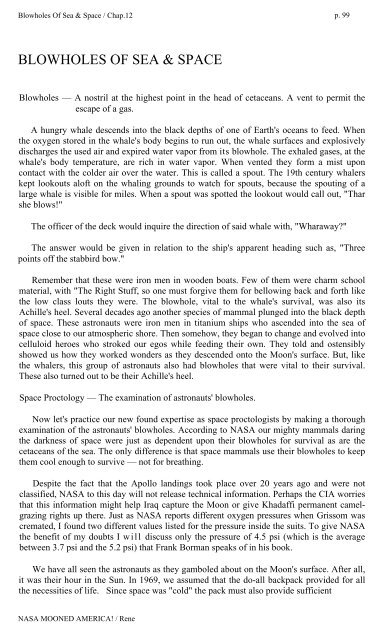Rene-NASA-Mooned-America
Rene-NASA-Mooned-America
Rene-NASA-Mooned-America
You also want an ePaper? Increase the reach of your titles
YUMPU automatically turns print PDFs into web optimized ePapers that Google loves.
Blowholes Of Sea & Space / Chap.12 p. 99<br />
BLOWHOLES OF SEA & SPACE<br />
Blowholes — A nostril at the highest point in the head of cetaceans. A vent to permit the<br />
escape of a gas.<br />
A hungry whale descends into the black depths of one of Earth's oceans to feed. When<br />
the oxygen stored in the whale's body begins to run out, the whale surfaces and explosively<br />
discharges the used air and expired water vapor from its blowhole. The exhaled gases, at the<br />
whale's body temperature, are rich in water vapor. When vented they form a mist upon<br />
contact with the colder air over the water. This is called a spout. The 19th century whalers<br />
kept lookouts aloft on the whaling grounds to watch for spouts, because the spouting of a<br />
large whale is visible for miles. When a spout was spotted the lookout would call out, "Thar<br />
she blows!"<br />
The officer of the deck would inquire the direction of said whale with, "Wharaway"<br />
The answer would be given in relation to the ship's apparent heading such as, "Three<br />
points off the stabbird bow."<br />
Remember that these were iron men in wooden boats. Few of them were charm school<br />
material, with "The Right Stuff, so one must forgive them for bellowing back and forth like<br />
the low class louts they were. The blowhole, vital to the whale's survival, was also its<br />
Achille's heel. Several decades ago another species of mammal plunged into the black depth<br />
of space. These astronauts were iron men in titanium ships who ascended into the sea of<br />
space close to our atmospheric shore. Then somehow, they began to change and evolved into<br />
celluloid heroes who stroked our egos while feeding their own. They told and ostensibly<br />
showed us how they worked wonders as they descended onto the Moon's surface. But, like<br />
the whalers, this group of astronauts also had blowholes that were vital to their survival.<br />
These also turned out to be their Achille's heel.<br />
Space Proctology — The examination of astronauts' blowholes.<br />
Now let's practice our new found expertise as space proctologists by making a thorough<br />
examination of the astronauts' blowholes. According to <strong>NASA</strong> our mighty mammals daring<br />
the darkness of space were just as dependent upon their blowholes for survival as are the<br />
cetaceans of the sea. The only difference is that space mammals use their blowholes to keep<br />
them cool enough to survive — not for breathing.<br />
Despite the fact that the Apollo landings took place over 20 years ago and were not<br />
classified, <strong>NASA</strong> to this day will not release technical information. Perhaps the CIA worries<br />
that this information might help Iraq capture the Moon or give Khadaffi permanent camelgrazing<br />
rights up there. Just as <strong>NASA</strong> reports different oxygen pressures when Grissom was<br />
cremated, I found two different values listed for the pressure inside the suits. To give <strong>NASA</strong><br />
the benefit of my doubts I will discuss only the pressure of 4.5 psi (which is the average<br />
between 3.7 psi and the 5.2 psi) that Frank Borman speaks of in his book.<br />
We have all seen the astronauts as they gamboled about on the Moon's surface. After all,<br />
it was their hour in the Sun. In 1969, we assumed that the do-all backpack provided for all<br />
the necessities of life. Since space was "cold" the pack must also provide sufficient<br />
<strong>NASA</strong> MOONED AMERICA! / <strong>Rene</strong>


